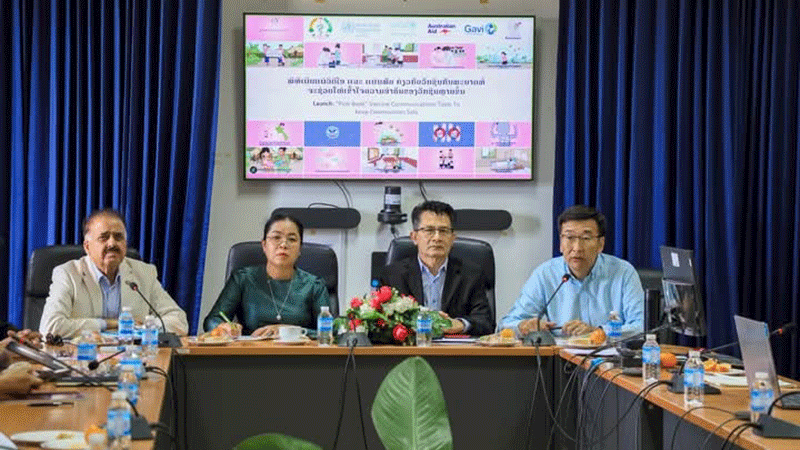 |
Officials from ministries and development partners attend the launch of the multilingual “Pink Book” on immunisation.
|
Health ministry provides shot in the arm for routine immunization
In a major step towards improving routine immunisation coverage, the Ministry of Health on Monday launched a new set of vaccination education tools based on the country’s iconic “Pink Book”.
Developed with support from the World Health Organisation (WHO), UNICEF, the Australian Government, and Gavi, the Vaccine Alliance, the new resources aim to improve understanding of vaccines among low-literacy populations and diverse ethnic communities.
Unveiled shortly after World Immunisation Week, the tools build on the trusted Mother and Child Monitoring Book—known locally as the “Pink Book”—which is distributed to every family in Laos.
The initiative is led by the ministry’s National Immunisation Programme and the Centre for Health Statistics and Information.
The new suite of materials includes animated videos and easy-to-understand infographic flashcards covering key topics such as how vaccines work, what to expect after vaccination, and information on eight major vaccine-preventable diseases: measles, polio, rubella, diphtheria, pertussis, hepatitis B, HPV, and COVID-19.
To ensure accessibility, the materials are available in Lao, Hmong, Akha, and Khmu dialects, as well as English.
Provincial and district health teams are continuing to translate the content into additional local languages, with support for healthcare workers to adapt the materials to minority languages as needed.
Deputy Director General of the health ministry’s Department of Hygiene and Health Promotion, Dr Viengkhan Phixay, said the resources would play a vital role in empowering frontline health workers and local leaders.
She said “Healthcare workers often face challenges in explaining vaccine science, especially to people with low literacy or language barriers. These new materials offer clear, visual explanations that are easy to understand and directly connected to the Pink Book, which communities already trust.”
The resources are designed for use on mobile phones and in printed form, making them suitable for both home visits and health centre use.
Gavi’s Senior Country Manager for Laos, Nadia Lasri, welcomed the launch.
“These tools are a powerful step towards ensuring all communities have access to reliable information about vaccines. They also help mothers track their child’s immunisation schedule, improving vaccine timeliness and coverage,” she said.
WHO Representative to Laos, Dr Timothy Armstrong, emphasised the importance of reaching the country’s most remote and underserved communities.
“By equipping healthcare workers and local leaders with culturally appropriate tools, we are helping to protect the health of every individual in Laos,” he said.
UNICEF Country Representative Bilal Aurang Zeb Durrani noted the long-standing role of the Pink Book.
“For decades, it has been a trusted companion for parents. Now, by turning it into engaging videos and visuals, we are bringing life-saving information into the hands of caregivers—whether in urban clinics or mountain villages.”
The Centre for Health Statistics and Information tested the materials among diverse communities in Vientiane and the provinces of Xaysomboun, Phongsaly, and Saravan, receiving overwhelmingly positive feedback.
While designed primarily for community outreach, the materials are publicly available via the Ministry of Health’s Centre for Health Statistics and Information Facebook page and the National Immunisation Programme’s YouTube channel.
With the addition of these new tools, the government and its partners hope to further improve vaccine understanding, acceptance, and uptake across the country.
By Times Reporters
(Latest Update May 21, 2025)
|


